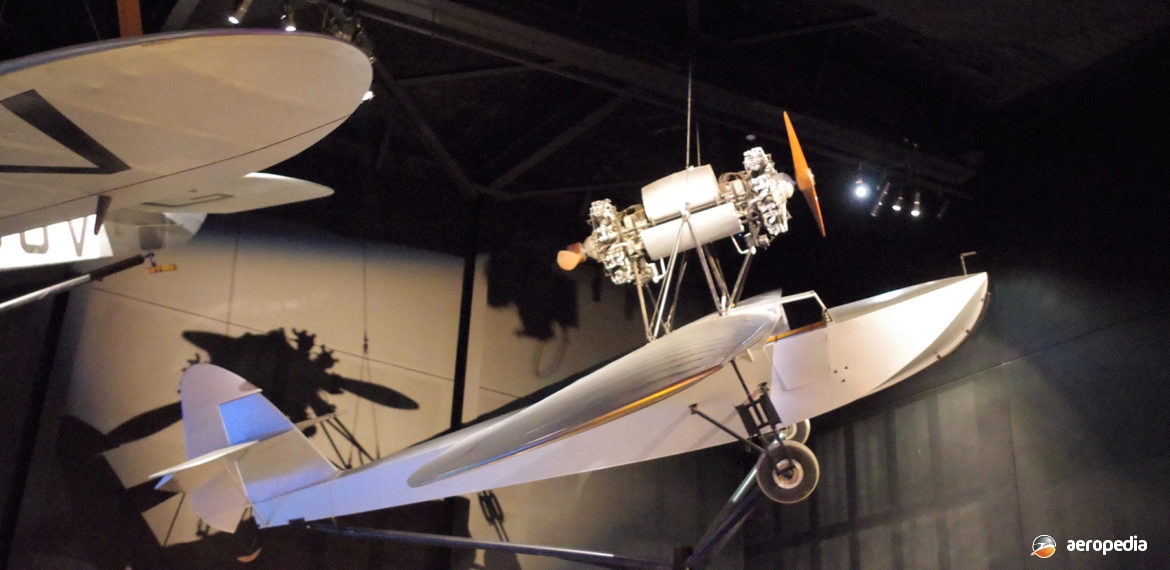Photograph:
Replica of the Hinkler Ibis on display at Bundaberg, QLD in 2016 (David C Eyre)
Country of origin:
United Kingdom
Description:
Two-seat light touring aircraft
Power Plant:
Two 34 kw (45 hp) Salmson AD-9 nine-cylinder air-cooled radial engines
Specifications:
- Wingspan: 11.58 m (38 ft)
- Length: 6.55 m (21 ft 6 in)
History:
The Hinkler Ibis was a foray into the design and construction of a light aircraft by one of Australia’s most famous aviators, Herbert “Bert” John Louis Hinkler. Born in Queensland in 1892, he obtained his pilot’s licence in 1913 and worked with the Sopwith Aviation Company at Kingston-on-Thames in Surrey, the company changing its name to the Sopwith Aviation & Engineering Company Ltd in June 1919. He eventually obtained a position as a test pilot with A V Roe (Avro) after World War I. Well known for his historic long-distance flights, his aircraft included the Avro Baby (G-EACQ) and the Avro Avian (G-EBOV), both of which have survived and have been placed on display in the Brisbane Museum, QLD.
Following his return to the United Kingdom after his 1928 flight to Australia, Hinkler formed Ibis Aircraft in partnership with Roland H Bound, and work commenced on building an all-wood shoulder-wing monoplane with a boat-like hull, with two engines mounted back-to-back above the wing centre-section. Seating two, the aircraft was designed to have twin-engine reliability. The wing was designed by Basil Henderson at Shoreham in West Sussex and built by Hendy Aircraft, the remainder of the aircraft being built by Hinkler himself at Hamble in Hampshire.
On 11 June 1929 the civil registration G-AAIS was allotted to the machine but it appears it was never actually applied to the aircraft. First flight was made at Hamble in May 1930 and handling was reported to be satisfactory. However, no manufacturer could be found and the aircraft was placed in storage at Hinkler’s home at Sholing near Southampton. It was removed from the British Civil Aircraft Register in 1933.
During a visit to the United States of America and Canada, Hinkler attempted to get funding to put the Ibis into production, at one stage stating he would replace the two Salmson radial engines with a de Havilland Gipsy in-line engine with the hope that this would assist with the aircraft’s handling. However, attempts to find funds failed, particularly as at that time the world was in the throes of the Great Depression.
In January 1935 Hinkler set off in a Canadian registered de Havilland DH.80 Puss Moth CF-APK (c/n 2049) in an attempt to break the England to Australia record but tragically crashed in the Italian Alps and, although he survived the crash, died on the mountain.
The Ibis aircraft remained in storage in a barn at Hinkler’s home at Mon Repos at Thornhill, Hampshire. However, following his demise his widow decided to move to South Africa to be with her daughter and the home was sold. Mrs Nance Hinkler, as she was known, Bert Hinkler’s common law wife, sought to donate the aircraft to a museum but there was no interest.
In 1952 the property was sold, the new owner seeking to convert the land to a caravan park and dispose of the aircraft. The aircraft was placed in open storage for a period and was obtained by the Hampshire Aeroplane Club, being taken to Eastleigh aerodrome. At this time a Mr Henry Stisted took possession of the aircraft with a view to restoring it. During early work the logbook of Hinkler’s flight in 1928 to Australia was located in the wing stub, along with a number of patents. At that time a Mr William Dunning, an engineer fitter, who worked with Hinkler at A V Roe, reclaimed the logbook and other Hinkler relics.
It was reported in the ‘Courier Mail’ (Brisbane – 16 March 1953) that Mr Stisted proposed to produce further examples of the Ibis for club members. The prototype aircraft was displayed at the Royal Aeronautical Society event at Hatfield in Hertfordshire on 14 June 1953 with a view to raising interest in producing the aircraft. However, little interest was shown in the project. Mrs Nance Hinkler subsequently attempted to have the aircraft returned to the family but it remained in the custody of Henry Stisted at his shipyard on the Solent.
Further efforts by the family, particularly Frances Hinkler, Bert Hinkler’s mother, continued with a view to obtaining the aircraft until July 1958 when she passed away. By that time Mr Stisted was in financial difficulties and was declared bankrupt. His business was taken over and the aircraft placed outside in the open where it fell into disrepair and eventually was burnt in the Lee-on-Solent area on 5 November 1959 on Guy Fawke’s Night.
In 1989 the Bundaberg Hinkler House Construction Committee in Queensland, which in 1982 dismantled Hinkler’s former home ‘Mon Repos’ (named after the beach where Hinkler had made his early glider flights) in Southampton and relocated it to Bundaberg, arranged to have a non-flying replica of the Ibis built.
Details of the original aircraft were sketchy and had to be built up from research and drawings obtained from the widow of Roland Bound. Nothing was available from the United Kingdom Civil Aviation Authority (CAA)as original certification data had been destroyed in a fire. However, using available information, the replica was completed and has been placed on display in Bundaberg as a memorial to a famous Australian aviator.

